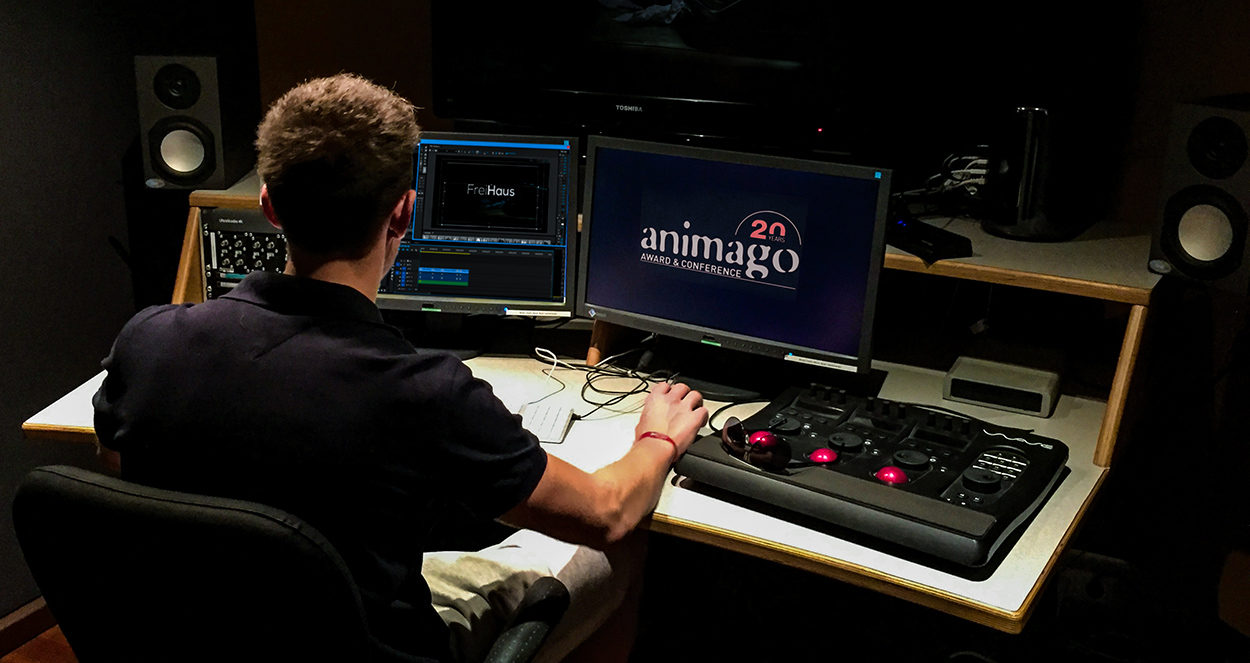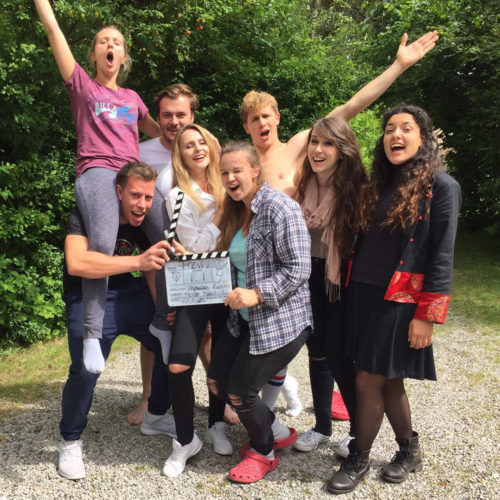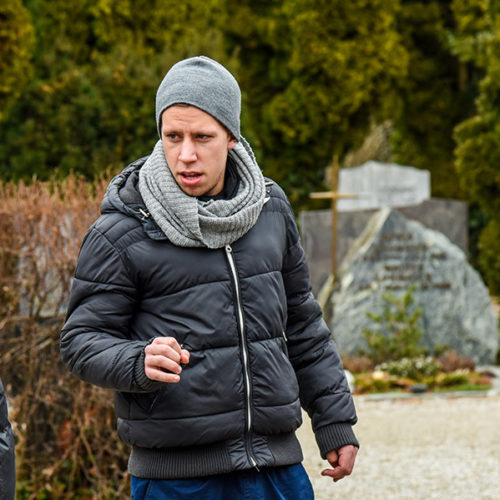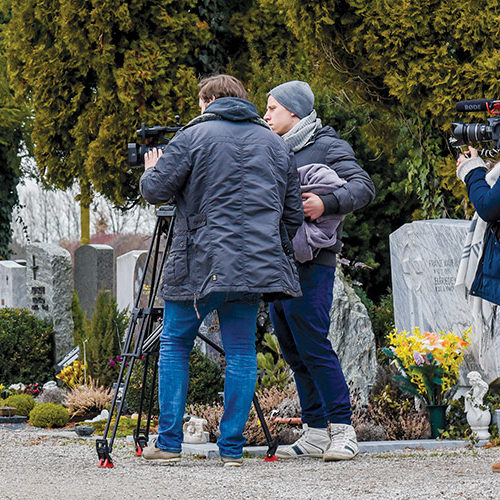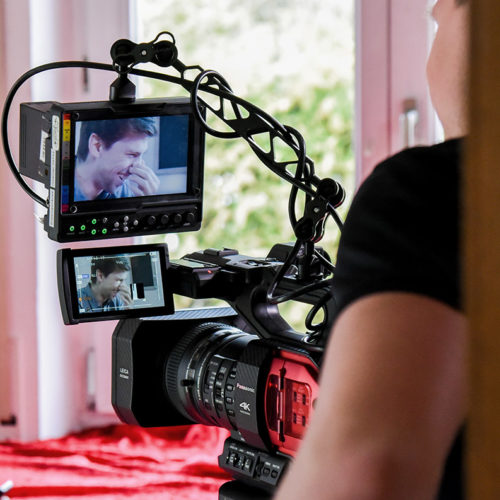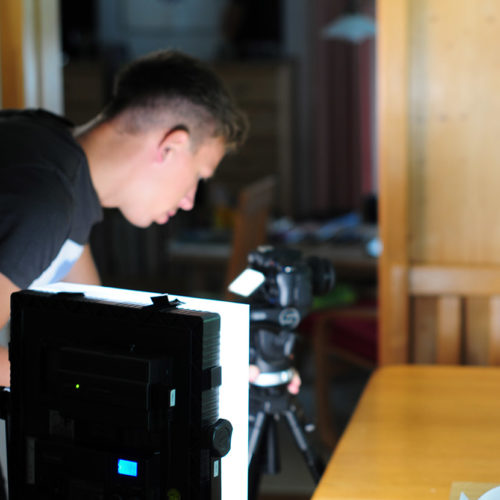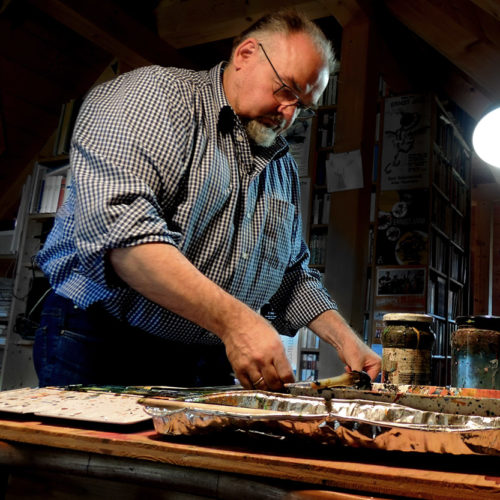Who edited the 20th anniversary trailers?
This year the animago guest list had one special name on it: SAE student Thomas Richter, who was responsible for creating the animago’s two 20th anniversary trailers. Richter also spent the first event of this year’s animago at Munich’s Gasteig Cultural Centre with a camera on his shoulder.
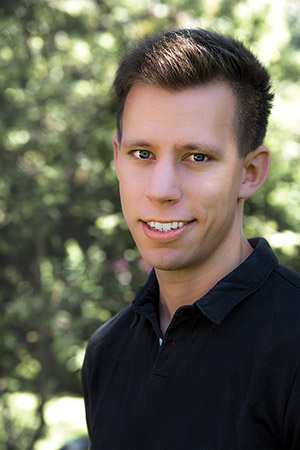
In the broad range of film productions Richter has completed at the institute so far, he has undertaken a wide spectrum of tasks, including production planning, cinematography, colour grading, compositing and much more. Of course, the larger the production, the more difficult these tasks become. However, for Richter, the clear favourite is editing; this is where he truly feels at home, and it also forms the starting point for his journeys into other areas of film production.
Practical projects
When Richter works as the producer of a film project, his first goal is to generate content that makes people think. And this is exactly what he did in his short advertising clip “12:34””, which thematises a famous quote from the bible: “For where your treasure is, there will your heart be also”. The spot was shot in a single day with six actors in three different locations in Freilassing, a Bavarian town near Salzburg, and was designed to remind viewers of the priorities we often overlook in our daily lives. For Richter, the complex, time-consuming preparations leading up to the shoot paid off, which meant that his team was able to complete the project quickly and successfully. Compositing was the most important task in the post-production phase.
In general, Richter most enjoys working in the area of dramatic productions. However, profiles and reportages hold a special attraction for him, and one of the many practical projects he completed at the SAE was his depiction of the complex life of Ernst Jani, a painter, musician and literary cabaret artist. The film was shot with a Sony Alpha 58 digital camera in the small city of Laufen on the Salzach River near Salzburg. Richter used additional lighting and four helping hands to complete the project – that was all he needed. Another project in the same genre was his reportage on the “Neuhauser Wohnküche”, a restaurant on Rotkreuzplatz in Munich. To make the short film, Richter and his team accompanied Sabine Lang – the “lady of the house” – for one full day. In addition to all the interesting details about the boss, her colleagues and the work itself, the student team gained tremendous experience primarily in how to handle people, whether protagonists or passers-by.
Beyond his work on practical SAE projects, Richter also gained additional technical expertise in a number of other productions at the institute; for example in the “breaking down” of scenes and in the “destruction” of a space as well as in different editing sequences.
Inspirational mojo: Coffee & music
No matter what kind of production he’s working on, Richter gets a good dose of inspiration from coffee as well as from chats with friends and acquaintances. For him, music is an especially important medium that helps him awaken that non-stop film running inside his head. Indeed, whether for creative ideas or relaxing daydreams, music accompanies Richter throughout his day; he plays guitar, sings, bangs on the drums and even occasionally accompanies bands on the Cajón. Aside from music, sport is also an important component in Richter’s life. Football has been high on his list of favourite activities since he was 16 years old. He also regularly wears himself out playing in tennis, volleyball and basketball, but also doing weight training and running on the Tartan track.
Future plans
In April 2017, Richter will complete his studies and, like all graduates, face the imposing question: “What now?” But no worries, this student already has his eye on a number of fields. On the one hand, opportunities such as editing the animago AWARD trailers provide fascinating challenges, and Munich offers the perfect location to pursue contacts in this area. On the other hand, however, he is eager to get involved in larger productions, although he insists it doesn’t have to be Hollywood right away. For example, Richter would love to work as a film editor on a prominent German or international production.
Interview with Thomas Richter
What made you decide to get your degree at SAE?
The origin of my passion for cinema – and my decision to pursue studies in the field – goes back to my secondary school days, when I decided to take a “P-Seminar Film”, which is a two-year practice-oriented seminar for which you produce a 20-minute short film. In that seminar, we learned the basics of cinematography, lighting, scripting and editing, and it ultimately made me want to turn my passion into my profession. The decision to attend the SAE was just me following the dictum “Follow in your father’s footsteps”; my dad did a degree in sound engineering at the SAE back in the day, and seeing as he got a solid education and was able to draw on great experiences there, it just seemed logical that I should go there too.
What kind of hardware and editing programmes do you work with? What did you use to edit the animago trailers?
I’m a Windows kind of guy. I’m just more familiar with the Windows interface, whether it’s a laptop or stationary computer. But Apple definitely has its advantages, and at university I work on Macs quite a bit. But no matter the hardware, my favourite editing programme is Adobe Premiere Pro. I know there are other programmes out there, but I edit faster with Premiere, so I use it for almost all my projects, including the animago trailers. For special motion effects, I used Adobe After Effects alongside Premiere.
Which editing programmes have you used in the course of your studies? Which ones did you learn to love, and which ones weren’t all that great?
I’ve worked with three different editing programmes so far. I edited my very first project, the 20-minute short film for the seminar I mentioned above, on an iMac using Final Cut. It was the best choice for the state of my knowledge at the time, because it was relatively easy to understand. Back then the only things that were important to me were the editing functions, and I didn’t go any deeper into the software itself. Then I edited my next projects using Adobe Premiere Elements, the light version of my current favourite, Premiere Pro CC. I was just getting started, so it was all OK, but from today’s perspective, the pro version is essential for my work. The colour grading mode in the latest versions is what keeps me coming back to Premiere. Another practical component is the tool’s compatibility with Adobe After Effects. In addition to the Adobe programmes, I also really like the Avid Media Composer. It’s true that it takes a bit longer to understand the interface, but after that it’s a highly reliable and multifaceted programme that is especially interesting for larger projects.
Do you have a favourite camera?
No, not really. The model I use always depends on what I’m using it for. In the field of reportages, I’ve shot a couple of things using the Panasonic AG DVX 200. I was very satisfied with the results and the performance of that camera, and its easy use and handling without a rig were also great. In the field of fiction, I’ve tried out a couple of SLRs, but I had especially good experiences with a RED Scarlet on my final graduating project.
What was your graduating project?
It’s the pilot episode of a series called “FreiHaus”, which I shot with my colleague Moritz Markulin. It’s about three female and two male students sharing a flat. In spite of their fundamentally different personalities, they have one thing in common: they are all enjoying and making the most their new-found freedom as students. I wrote the screenplay and took over sound and directing duties on the production, as well as editing and sound mixing in the post-production phase. The whole thing enabled me to gather a whole bunch of new experiences. The pilot episode was released in mid-September 2016.
What criteria did you use to choose the clips for the animago trailers?
I did my research first, of course, and watched all the previous animago trailers, which gave me lots of good ideas. Generally, I sorted the clips – or parts of them – into special categories. There were a number of key subject areas that presented themselves, including “human”, “animal”, “machine” and “nature”, but also moods and feelings, such as “optimism”, “fear”, “love”, “making a new start” and the like.
And the animago stills for the second trailer?
I categorised the stills in a similar fashion to the video clips. The colours and the type of still played a big role in this case, whether they were photorealistic or more comic-oriented.
What kind of effect did composer Gordon Krei’s music have on your editing style?
Gordon Krei’s music gives editors a broad spectrum of possibilities: he’s got fast-paced, rock-out passages alternating with slow-paced, more emotional sections, and these produce either light-hearted or more threatening moments. The first time I heard the music it already conjured up certain images, editing sequences and speeds in my mind, so after that the “only” thing I had to do was find the perfect images to fit my ideas.
What kinds of tricks have you developed to adapt clips to music?
There are a number of ways to bring music together with images. For example, in After Effects you can keyframe the music, which means that the beat or the base drum is available to you as a form of orientation while you edit. But I’m not always a fan of having the images edited to fit the beat throughout an entire song. Offbeat edits that don’t perfectly fit the beat are also welcome, and the way they are ultimately used is more or less a question of feeling.
How was the SAE able to help you get a good start in the VFX and film industry until now?
The SAE supports us students in many situations in a very individual way, for example, with professional equipment that we can borrow and practice on. We also get ideas and gain contacts via our professors and lecturers. In other words, we’re invited to create connections between our lives in the academic world and the industry itself. For example, in my case, it was through the SAE that I was asked to edit the animago trailers, which was a great opportunity for me.
What are your post-animago plans?
I’m just finishing up my university-level studies at the SAE now. In my Bachelor programme, I’ve still got the big interdisciplinary graduating project to complete, plus I’ve got to write my Bachelor thesis. When I finish my studies in early April 2017, I would love to work as an editor and get even more practical experience in the “real” world. I don’t have my eye on any one company in particular, but I would definitely be interested in gaining experience abroad.
(Mirja Fürst)

